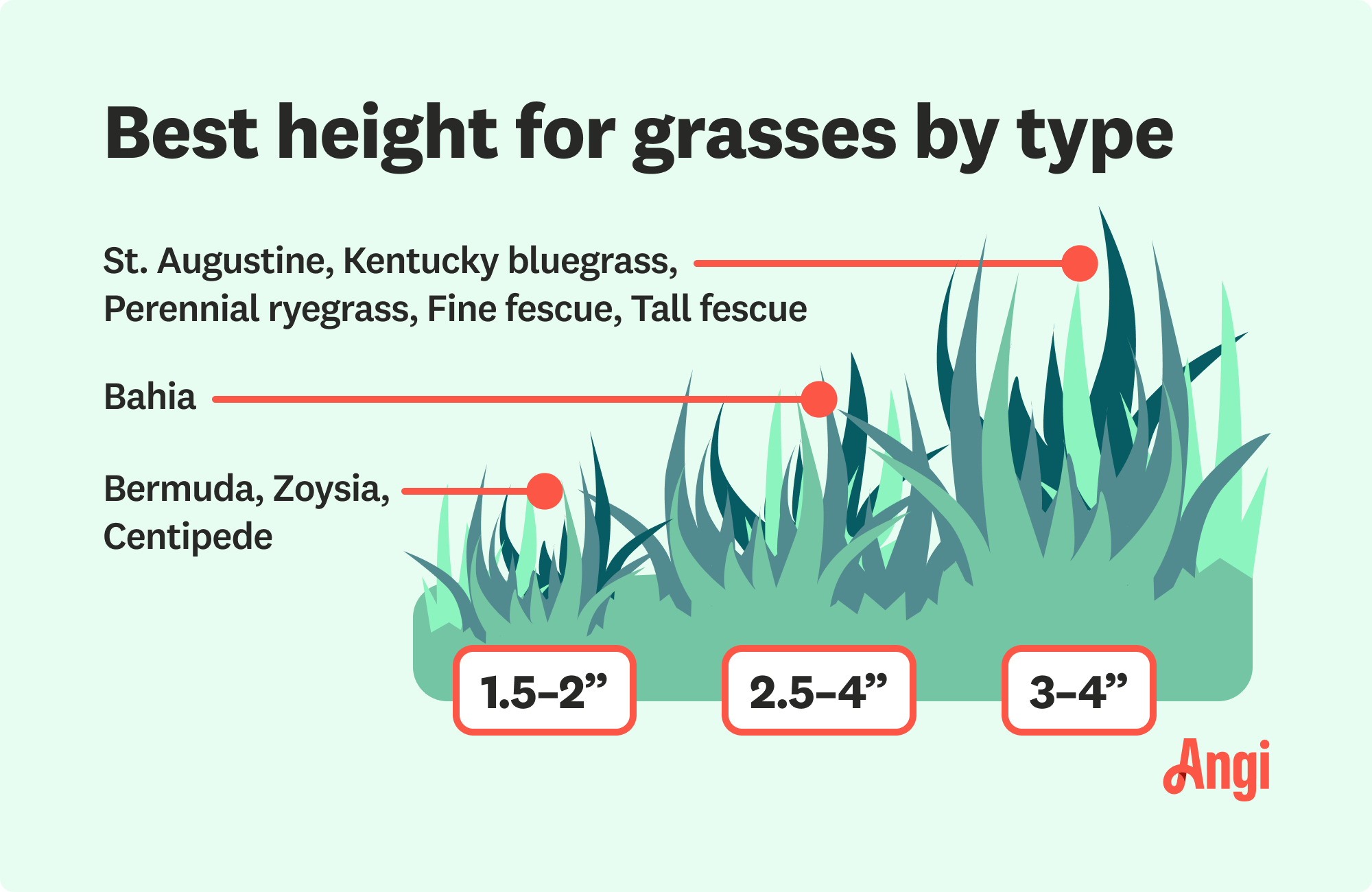
How much it costs to rent a lawn aerator depends on what kind you rent and how long you rent it for. Read on for the full details.
Avoid a dead, scalped lawn or a shaggy, ankle-length grass jungle with our mowing tutorial


The ideal grass height is 2 to 3 inches for most popular types.
Warm-season grasses, such as Bermuda and centipede grass, should be kept shorter at 1 1/2 to 2 inches.
Cool-season grasses, such as fescue and Kentucky bluegrass, should be kept longer at 3 to 4 inches.
If you haven’t been mowing your lawn to its recommended height, start now and allow at least one year to re-establish a healthy lawn.
The best height to cut grass usually is 2 to 3 inches, but it depends on your climate. Cool-season grasses should be left long at 3 to 4 inches, while warm-season grasses should be cut shorter at 1 1/2 to 2 inches. In general, weekly mowing maintains the ideal grass height, but shorter varieties may require more frequent mowing. Take a look at our handy guide to learn how best to mow your lawn.
The optimum height for most grasses is 2 to 3 inches. However, a few types of warm-season grasses do better shorter, including Bermuda grass, centipede grass, and zoysia grass, which you should keep at 1 1/2 to 2 inches for the best performance.
Also, consider that, if you're overseeding your lawn, you should cut your grass around half an inch shorter than normal to allow the new seed you lay to better penetrate between the grass blades and reach the soil. Then, let your lawn grow to half an inch higher than normal before you mow it back to its optimum height.

Yes, grass type affects the ideal mowing height. Some warm-season grasses do better when kept shorter, but cool-season grasses perform better and remain healthier when kept slightly longer.
Just remember that whatever the type of grass you have, cutting it too short damages the grass, increases evaporation in hot weather, and can damage the soil health, too. If you’re not confident in your lawn mowing abilities—or simply don’t have the time to devote to it—a local lawn mowing service can keep your yard in tip-top shape. Professional lawn mowing costs an average of $50 to $205.
Take a look at the most common types of lawn grass seed and the optimum growing height:
| Grass Type | Ideal Grass Height (Inches) |
|---|---|
| Bahia | 2.5–4 |
| Bermuda | 1.5–2 |
| Centipede | 1.5–2 |
| Fescue | 3–4 |
| Kentucky bluegrass | 3–4 |
| Perennial ryegrass | 3–4 |
| St. Augustine | 3–4 |
| Zoysia | 1.5–2 |
While you could get down on your knees and measure grass height each time you mow, spare yourself additional bending and stooping and draw a line on your preferred mower tire at 3 ⅔ inches off the ground. That way, when it’s time to mow, you’ll just push your mower out, review, and get to cutting.
Here’s how to measure and maintain your grass height easily using your lawn mower’s tire adjustment options:
With the mower on a level surface, use a marker (or similar utensil) to mark a line on your preferred mower tire at 3 ⅔ inches off the ground.
Explore the tire adjustment options on your mower to ensure the marked height aligns with the actual cutting height of the mower blades (this may require some trial and error).
Test the mower on a small section of grass to see if the cutting height matches your desired grass height.
When it's time to mow, simply push your mower out to the lawn, ensuring the marked tire is facing the ground.
Periodically check the tire marking and mower blade height to ensure they are still aligned with your desired grass height, making adjustments as necessary.

Mowing isn't an exact science and, although there are some general guidelines for the ideal length of grass by type, you can't necessarily just mow the lawn straight to this height. To maintain the health of your grass, you should never cut off more than 1/3 of its height.
If you've been on vacation, for example, and you come home to see your lawn has reached a whopping 6 inches, you can't just hack it back to 3. If you do, you'll shock it, and there's a good chance you'll kill large swathes of it or leave it vulnerable to disease. Your lawn can take a full season or more to recover.
To solve the problem of an excessively long, scraggly lawn, you mow it by a maximum of 1/3 of its height, and you increase the frequency with which you mow to once per five to seven days until you bring it back to the optimum length. Then you can return to your regular mowing schedule.
From average costs to expert advice, get all the answers you need to get your job done.

How much it costs to rent a lawn aerator depends on what kind you rent and how long you rent it for. Read on for the full details.

The cost to renovate your lawn depends on the extent of the damage. Our guide will show you how much lawn renovation costs.

Removing an old lawn is often necessary to plant new grass or build a new outdoor structure. Find out what to budget for your lawn removal cost.

Need to know how to kill clover in your lawn? Learn the best methods to get rid of clover weeds without killing your grass or other plants.

Curious how to kill weeds in your grass and keep them from popping up every season? Here are five weed-fighting methods to beautify your lawn.

Does sugar help your lawn? In some cases, yes. Keep reading to learn how you can use this sweet treat to kill weeds and keep the grass green.